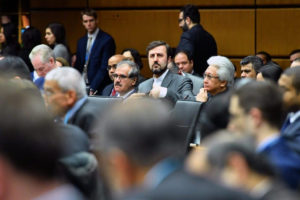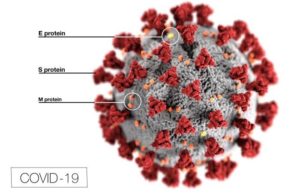March 17, 2020
George M. Moore
This article is part of World War “V”: The COVID-19 Pandemic, a collection of all CNS COVID-19-related articles.
The following is an excerpt of an article published in the Bulletin of the Atomic Scientists.
The health and humanitarian crisis of the Covid-19 outbreak has now been declared a pandemic by the World Health Organization. In attempting to control the spread of the virus, the world community is responding with extraordinary measures, including travel bans. On March 11, the United States announced that it was banning entry for foreigners coming from a group of European countries, alongside similar restrictions already in place for travelers coming from China. Many other countries, too, have established similar travel bans and restrictions, either for valid health concerns or in retaliation for bans against their own citizens.
[…]
Iran’s representative to the IAEA, Kazem Gharib Abadi, during the agency’s Board of Governors meeting, March 2020. Photo Credit: Dean Calma / IAEA
In Iran, the virus is widespread, affecting even senior government officials. Those who have tested positive for coronavirus include Vice President Eshaq Jahangiri, Minister of Culture Ali Asghar Mounesan, and Minister of Industry Reza Rahmani. Moreover, the virus has already claimed the lives of senior politicians such as Hossein Sheikholeslam, the country’s former top ambassador to Syria, and Mohammad Mirmohammadi, a confidant of the supreme leader and member of the Expediency Council. As covered extensively by the media, even Iranian health officials have appeared on camera displaying flu-like symptoms. The US Centers for Disease Control and Prevention has designated Iran as a Level 3 country, meaning that all nonessential travel to Iran is suspended, as it is for China and the whole of the European Schengen zone.
[…]Whether Iran would attempt to use the cover of Covid-19 to begin a dash for a nuclear weapon is uncertain. However, the loss of “eyes on the ground” in the form of IAEA inspections would probably heighten the worst fears about Iranian proliferation and possibly worsen already dim prospects for cooperation. Even before the coronavirus breakout, Iran had expanded its production of enriched uranium, probably in an attempt to exert pressure and improve its negotiating leverage following the Trump administration’s withdrawal from the deal and its reimposition of sanctions in 2018.
A second and related danger is that, absent the IAEA inspections, there is a greater possibility of miscalculation regarding Iran and its nuclear potential and intentions. Without hard data, US policy makers could begin to fear the worst and assume that Iran was dashing toward a bomb, and it would be difficult to prove otherwise. Other nations, both Iran’s neighbors in the Middle East and other global powers, might also react in unexpected ways, based on insufficient information and fear that Iran was breaking out to produce a nuclear weapon. In any event, lack of information generally leads to instability and whenever nuclear weapons, or the threat of nuclear weapons, is involved, instability could be exceedingly dangerous.
Continue reading at the Bulletin of Atomic Scientists
See Also
 World War “V”: The COVID-19 Pandemic
World War “V”: The COVID-19 Pandemic
A collection of all CNS COVID-19-related articles
